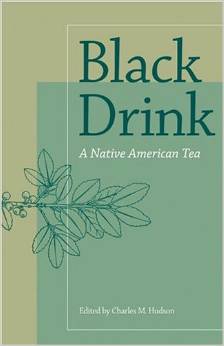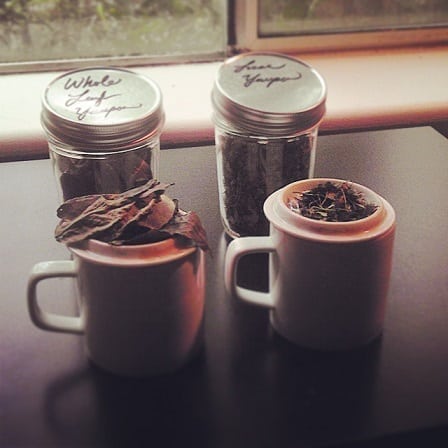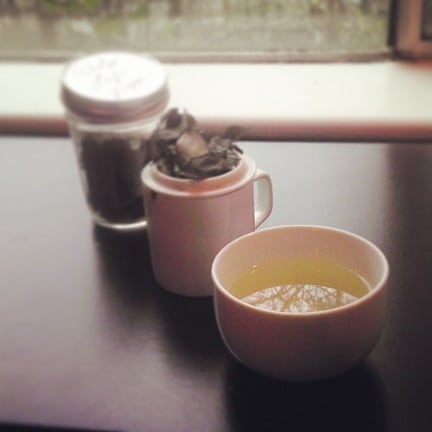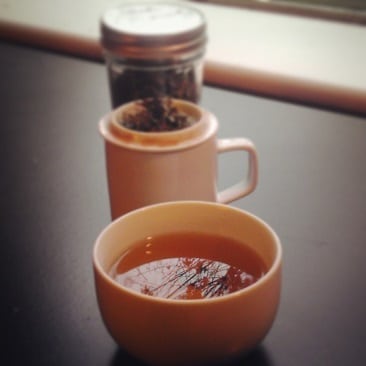Yaupon is a species of holly native to the southeastern United States. It is a close cousin to two other holly species – guayusa and yerba mate – and, like those, it is also caffeinated. It was used as a common ingredient by several Native American tribes in an herbal concoction called asi – or “black drink”. Said tisane was an important part of male-only purification rituals.
In 1696, a Quaker merchant – Jonathan Dickinson – observed this ritual firsthand among the Ais people of pre-statehood Florida. The ritual included an unfortunate result . . . vomiting. Since then, European settlers incorrectly assumed that it was the primary herb that induced the reverse peristaltic reaction. And, so, the plant was given the unfortunate delineation – Ilex vomitoria.
A book was even written about the subject.

For years after learning of this “black drink”, I was fascinated by it. Yet no one had bothered to try and cultivate it, yet. Aside from some random YouTube videos describing it tasting like yerba mate, I found no one selling the stuff. Unless I wanted to go to Florida and pick it myself, there was no way I was going to try it. Perhaps folks didn’t think they could market something called “vomitoria”. Wonder why?
That all changed around 2012. Small outfits started cropping up touting this “new, American caffeinated herb”. Perhaps it was due to yerba mate’s rise in popularity, or the insurgent arrival of guayusa on the herbal infusion market. Whatever the reason, it was finally here.
I didn’t get my first chance to try it until World Tea Expo 2014. A company out of Florida called Yaupon Asi Tea had a booth. Available for tasting were some of their blends and their flagship cut yaupon. I remember it tasting a lot like guayusa, which was a good thing. (I wasn’t the biggest fan of yerba mate.)
After the Expo, I got in touch with them to acquire some for a comparison. Among their many wares, they carried both a whole leaf version of yaupon and a cut leaf variant. The whole leaf version was there because it was the more traditional presentation of the herb. A side-by-side tasting intrigued me.

Several months later (er, just yesterday) I finally sat down and gave ‘em a whirl.
The whole leaf yaupon had an appearance of – well – whole leaves that were freshly picked and oxidized. I was quite surprised to see a purplish hue to some of the leaves – likely due to an abundance of the chemical, anthocyanin, also found in Kenyan purple tea. As for aroma, there wasn’t much of one besides a dry, forest-bedding-like presence.
The cut leaf version was a markedly different beast with needle-like parts along with the requisite leaf parts. The color of the leaves was greener with some purple strewn about. The aroma was also more minty, sweet and welcoming. It reminded me strongly of guayusa in this form.
For brewing, the directions on the Yaupon Asi Tea site were fairly straightforward. They recommended a standard herbal approach – boiling water, five-minute steep. I did exactly that to both.
The whole leaf yaupon came out practically clear in the cup.

Even more so than a white tea, at least those had a yellow tinge to the liquor. There was a bit of a flavor change, but one had to search for it. It reminded me of tangy olive leaves and a bit like mint. Some residual sweetness showed up on the finish, but – like the rest – it was mild.
This required a second attempt with moar leaves at a longer steep time. Seven minutes sounded about right.

Vast improvement. Some color showed up in the liquor, and the flavor – while still subtle – was sweet and spry.
The cut leaf version was . . .

Woooonderfuuuuullllll.
The liquor was a deep amber-green – giving off a sweet, almost artichoke-y aroma. On taste, it opened with a sweet and herbaceous kick – similar to guayusa – dried out a little in the middle like yerba mate, but ended with straight creaminess on the back. It was far more layered than either of its holly cousins. And, dang, if I didn’t bolt upright from a caffeine kick or three.
I liked both versions quite a bit and for different reasons. The whole leaf yaupon worked as a late-afternoon pick-me-up, whereas the cut leaf was a balls-to-the-walls get-your-ass-outta-bed morning beverage to the core. For overall flavor experience, if I was pressed, I’d choose the cut leaf as an everyday beverage. Sure, the whole leaf is more traditional, but I’m not really a traditional kinda guy.
All said, I was glad to have yet another two tastes of ‘Merica in my cup(s) – sans vomiting.

Leave a Reply to Xavier Cancel reply